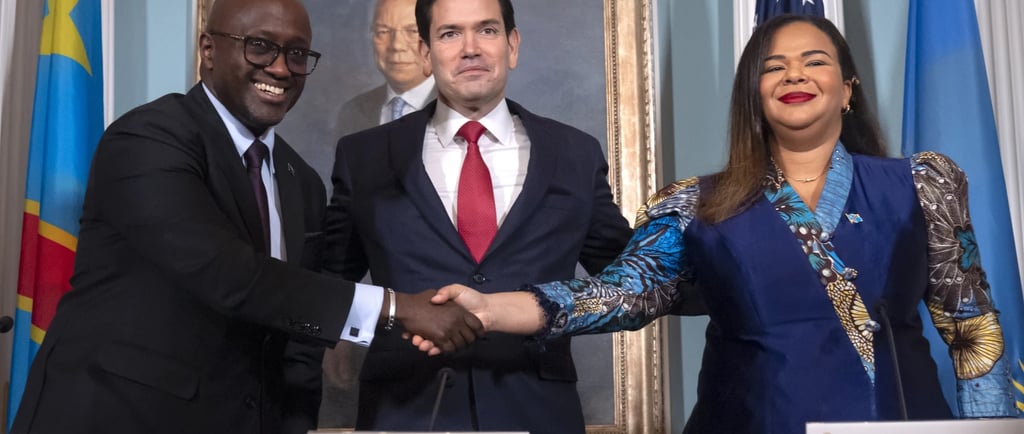Hope for Millions as Congo and Rwanda Sign Landmark Peace Agreement
After decades of protracted conflict rooted in the 1994 Rwandan Genocide, the Democratic Republic of Congo and Rwanda have signed a historic peace agreement to end hostilities in eastern DRC, focusing on cause, structure, and risk transmission mechanisms. Will this new agreement solidify a lasting peace, or will its foundational challenges once again lead to instability?
DEMOCRATIC REPUBLIC OF THE CONGORWANDA
Nurila Nursalimova
7/1/20253 min read


The Democratic Republic of Congo (DRC) and Rwanda have experienced tense relations for three decades, being called one of the longest-running conflicts in the world. However, on Friday (June 27), the foreign ministers of both countries signed a peace agreement in Washington, aimed at ending the hostilities in eastern DRC. The U.S. Secretary of State, Marco Rubio, was present at the ceremony.
The roots of the conflict go back to the 1994 Rwandan Genocide. In just 100 days, extremists from the majority ethnic group in Rwanda, the Hutus, killed around 800,000 people. Most of the victims were Tutsis, a minority ethnic group. The genocide came to an end when a Tutsi-led rebel group took control of Rwanda’s capital, Kigali, and seized power. During and after the genocide, hundreds of thousands of Hutus fled over the border to refugee camps in eastern DRC (then called Zaire). But among them were some of the extremists who had taken part in the killings. These groups remained active in the region, launching attacks and posing a threat to Rwanda’s security. In 1996, two years after the genocide, Rwanda invaded the DRC to go after these Hutu militia groups, and that event is known as the First Congo War.
At that time, Zaire (now the DRC) was ruled by Mobutu Sese Seko, a dictator who governed for 26 years, and had lost power inside and outside the country. Rwanda and Uganda helped a rebel leader, Kabila, overthrow Mobutu in 1997. Kabila renamed Zaire to the Democratic Republic of Congo and became president. Once in power, Kabila cut ties with Rwanda and Uganda, ordered their troops out of the country, and stopped cooperating with them. In response, Rwanda and Uganda supported new rebel groups, especially the Rally for Congolese Democracy (RCD), to try to remove Kabila from power. This led to the outbreak of the Second Congo War (also known as the Great African War). It was one of the deadliest conflicts in modern history, lasting from 1998 to 2003, and involved 9 African countries with millions of lives lost.
Even twenty years later, the eastern DRC was still being fought over. One of the main groups involved in the ongoing conflict had been the M23 rebel group, which was formed by soldiers from another rebel group, CNDP (National Congress for the Defense of the People), and operated in eastern DRC. These soldiers had previously made a peace agreement with the DRC government on March 23, 2009 (thus, the name is M23). However, in 2012, they emerged again, claiming that the government failed to fully implement the terms of that peace deal. After they were withdrawn, M23 came back in 2021, capturing Goma and Bukavu cities. It is estimated that M23 has 6,000 fighters, but a lot of people say they could not have taken all this territory without Rwanda’s help. The Congolese government accuses Rwanda of supporting M23 to maintain influence in the mineral-rich eastern region, while Rwanda denies this, claiming it is protecting its borders from the FDLR (Democratic Forces for the Liberation of Rwanda). In response, the East African Community (EAC) and the African Union (AU) facilitated negotiations. In 2024, with the help of regional leaders and international partners, the DRC and Rwanda agreed to a peace deal that includes: a ceasefire; working together to control their shared border and prevent rebel activity; disarmament of rebel groups in each country; guarantee of safe return of each country’s refugees; launching joint projects, such as road building and trade agreements for creating jobs and strengthening local economies.
The DRC and Rwanda also have set plans for the future: conduct talks with rebel groups for peace; regional organizations will observe both sides to make sure they keep their promises; invest in building schools, hospitals, and infrastructure to recover economic states; and increase citizens’ trust by creating stronger political systems to reduce corruption.
In conclusion, if this agreement is followed successfully, there could be tremendous benefits: the DRC and Rwanda can help stabilize other African countries too, like Uganda and Burundi; trade between the two countries will improve, creating jobs and reducing poverty; a peaceful region will attract more foreign investment and future perspectives. Most importantly, peace will bring hope and safety for millions of people in eastern Congo who live in fear due to armed violence.
The DRC-Rwanda Peace Agreement is a major achievement toward solving one of Africa’s most complex conflicts, offering hope for a better future. This peace deal is an action towards saving millions of lives and hearts. With the support of the international community and the commitment of both countries, ultimate peace can be achieved again.


